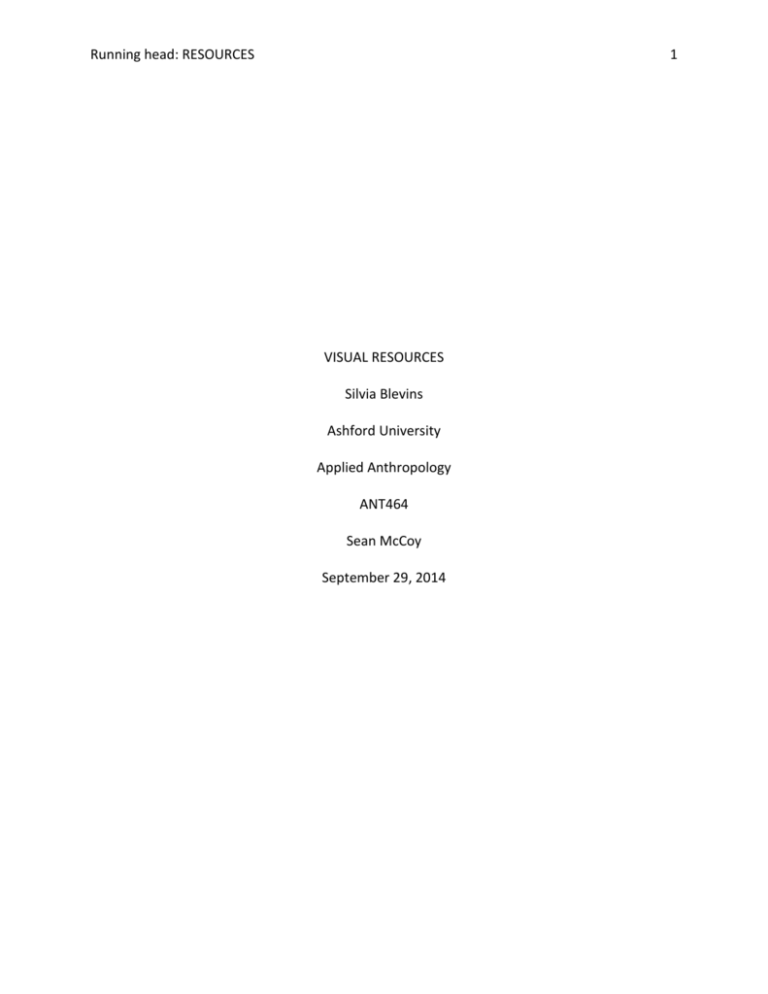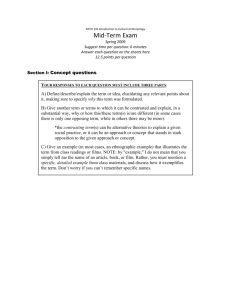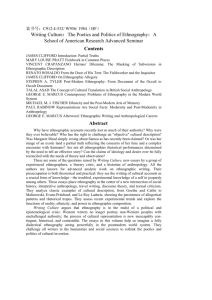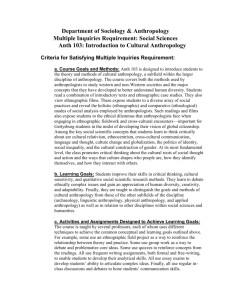Visual Applied Anthropology
advertisement

Running head: RESOURCES 1 VISUAL RESOURCES Silvia Blevins Ashford University Applied Anthropology ANT464 Sean McCoy September 29, 2014 RESOURCES 2 VISUAL RESOURCES As an applied anthropologist who is attempting to create a plan of action in order to request a change in educative policy for Cabarrus County, I need to prove the project’s need but also to prove its effectiveness. To do so, I need to gather informative data from different sources and incorporate visual applied anthropology to better explain people’s needs, wants and explain social phenomena. My project will attempt to modify local policy and request government funding to have more ESL teachers for non-English speaking children. Visual anthropology will focus on “children” and will attempt to sell my project by offering sociocultural sensitivity towards the visual representation of “children” and their needs to suggest social change. Images, video and web-based media are often part of ethnographic work. Visual technologies are not only useful gathering data but also offering information. I will use them all to gather information but also to expose it to the government officials and additional intended audience. To fundament my research, I will use statistical methods to test the hypotheses about the subject and measure whether such policy will indeed be necessary. Analyzing and using statistics is a common practice in policy planning (Ervin, 2005 pg 190), so this method seems trustworthy and overall verifiable; something very important when attempting to change policy since policy makers will seek to make a decision based on reliable data rather than people’s assumption of what their needs are (Ervin, 2005). For that purpose, I will use the most current federal census for updated demographic numbers. In addition, I can evaluate other relevant variables such as age, sex, occupation, religion and ethnicity, indicators that will aid in narrowing my group of study. In this case, I was able to maneuver through the following website http://factfinder2.census.gov/. Another very important source of information was obtained from the County Health Department where community statistical indicators for Cabarrus County from January 2012 were perfectly charted as part of the “Secondary Data Collected as part of the 2012 Community Needs Assessment” I was offered strengthened descriptions of context (Ervin, 2005 pg. 189) as it builds on previous research and reinforces the decision of my proposed project’s site. Because of its reliability, I obtained demographics for the subgroup from this website. It included charts about school demographics and ethnicities of school populations by districts. This 68 page needs assessment reinforced the already established hypothesis that stated: “Hispanic children in Cabarrus county N.C. need to have ESL classes offered to them since they start school.” A full essay can be reviewed at: www.cabarrushealth.org/DocumentCenter/View/108. Demographic and statistical data will also monitor the needs in society and may aid in shaping policy. For instance, if non-English-speaking immigrants increase, it might suggest the need of ESL classes in schools. In addition to providing reliable data to my audience, I also need to include the human factor. Unlike other disciplines, anthropology also focuses on the human aspect of the scientific research. For that, visual images of the actual problem could capture people’s perceptions, experiences, issues, and needs (Pink, 2005). Images have the power to inspire us, narrate a story and describe my problem but images could also offer a solution. For instance, the image to the right could show me more than only children in a classroom eager to participate. It could show me that my project would be helpful and effective. As just showed, an image if chosen correctly could really help an anthropologist to get his/her point across in a very persuasive manner. Since the purpose of applied visual anthropology is to offer sociocultural sensitivity by explaining lifestyles, cultures, and societies; ethnographic documentaries may prove quite helpful (Pink, 2009. Nowadays, most ethnographic research is intertwined with visual technologies (Pink, 2013). Visual ethnography theory is explained in http://www.youtube.com/watch?v=gD-Pjzz7LfU . Depending on my budget, I will produce a video documentary where I will show the need and acceptance of ESL classes. I will film children in a classroom and also randomly ask several questions to some of them to allow the audience a clear vision of the problem. In the following link, you could see the outline for the proposed idea: http://www.youtube.com/watch?v=-bWU238PymM . I can complete such documentary in a short timeframe. First, I must seek school approval and parental consent. An applied anthropologist often relies in technology to gather information because of time or distance. Nowadays, modernity allows the use technology not only for ethnographic research but also presentation. Using visual applied anthropology, I will gather information to create and fundament my project but also to exhibit my findings in a way that I get my point across without many words but one that is visually believable. References: Pink, S. (2013). Doing Visual Ethnography. Berghahn Books Pink, S. (2009). Visual Interventions: Applied Visual Anthropology. United States: Berghahn Books . U.S. Census Bureau. (2013). State and County QuickFacts. Retrieved from: http://quickfacts.census.gov/ Visual Ethnography –Current Theory (Uploaded 2009). Retrieved from: http://www.youtube.com/watch?v=gD-Pjzz7LfU ESL Struggles and Strategies Retrieved from: http://www.youtube.com/watch?v=bWU238PymM








